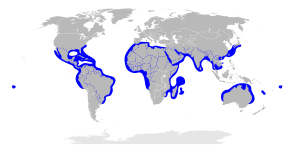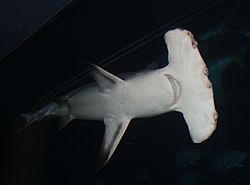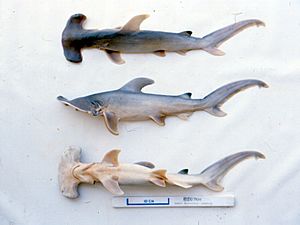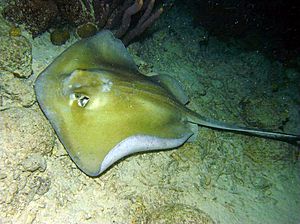Great hammerhead shark facts for kids
Quick facts for kids Great Hammerhead Shark |
|
|---|---|
 |
|
| Conservation status | |
| Scientific classification | |
| Kingdom: | |
| Phylum: | |
| Class: | |
| Subclass: | |
| Order: | |
| Family: | |
| Genus: | |
| Species: |
S. mokarran
|
 |
|
| Range of the Great Hammerhead Shark (In blue) | |
The Great Hammerhead Shark (Sphyrna mokarran), is the largest species of the Hammerhead shark group. It can be identified by the shape of its "hammer" (called the "cephalofoil"), which is wide and has an almost straight margin at the front, and by its first dorsal fin which is tall, and is sickle-shaped.
Contents
Description
Like all other Hammerhead sharks, the Great Hammerhead Shark has a streamlined body and a "hammer" on its head. They have usually been confused with the Scalloped Hammerhead Shark and the Smooth Hammerhead Shark, but adult Great Hammerhead Sharks can be identified by their wide cephalofoil which has an almost straight margin at the front, and by their first dorsal fin, which is tall and sickle-shaped. The cephalofoil is usually around 1 to 1.5 meters long.
Great Hammerhead Sharks are around 2.85 to 5.5 meters long, and weigh around 450 kg, but the longest ever found was 6.1 meters long. The heaviest ever found was a 4.4 meter long female, which weighed 580 kg, and was caught off Boca Grande, Florida. But the female weighed this much because it was pregnant. The top part of the Great Hammerhead Shark is grey-brown or green, and the belly is white.
Where they live
The Great Hammerhead Shark is found in tropical waters around the world, between the latitudes 40°N to 37°S. In the Atlantic Ocean it is found from North Carolina to Uruduay, including the Gulf of Mexico and the Caribbean Sea, and from Morocco to Senegal, and the Mediterranean Sea. It is found all along the rim of the Indian Ocean, and in the Pacific Ocean from the Ryukyu Islands to Australia, New Caledonia, and French Polynesia, and from southern Baja California to Peru. It's said to be found off Gambia, Guinea, Mauritania, Sierra Leone, and Western Sahara, but this has not been confirmed. Great Hammerhead Sharks can be found from inshore waters which are less than 1 meters deep, to a depth of 80 meters offshore. They live mainly in coral reefs, but have been found in lagoons and deep water near land.
Behaviour
Even though Great Hammerhead Sharks are apex predators, young pups have been seen eaten by Bull sharks. Yellow jacks have been seen rubbing themselves against Great Hammerhead Sharks, probably to get rid of parasites. Pilot fish have been seen swimming with Great Hammerhead Sharks.
Reproduction
Great Hammerhead Sharks are viviparous, meaning they give live birth. Females are pregnant for around 11 months, before giving birth to a litter of 6-56 pups. When they are born, the pups are around 50–70 cm (20 to 28 in) long. Males mature when they are about 2.3 to 2.8 meters long, and weigh around 51 kg. Females mature when they are about 2.5 to 3 meters long, and weigh around 41 kg. Great Hammerhead Sharks live for around 20–30 years, but the oldest Great Hammerhead Shark ever found was said to be 40–50 years old.
Feeding
Great Hammerhead Sharks are known to hunt at dawn and at dusk. They feed on crustaceans like crabs and lobsters, molluscs like squids and octopuses, bony fish like tarpon, sardines, herrings, sea catfish, toadfish, porgies, jacks, croakers, groupers, flatfish, boxfish, and porcupine fish. They also eat other sharks like smoothhounds and grey reef sharks. Great Hammerhead Sharks have been known to eat others of their kind.
Great Hammerhead Sharks' favourite prey are rays and skates; its favourite type of ray are stingrays. The venomous spines of the stingrays don't seem to affect them, because a Great Hammerhead Shark caught off Florida had 96 venomous spines found in and around its mouth. The cephalofoil of the Great Hammerhead Shark is said to be used to pin stingrays down, because one Great Hammerhead Shark was found attacking a southern stingray in the Bahamas; the Great Hammerhead Shark first pinned the stingray down by hitting the stingray with its cephalofoil, and then it grabbed the stingray in its jaws and started to rip apart the stingray by shaking its head rapidly. Another Great Hammerhead Shark was found attacking a spotted eagle ray in open water; the Great Hammerhead Shark first bit off one of the ray's pectoral fins, and then pinned the ray down with its cephalofoil, and then ate the ray head-first.
Human interactions
Although they have been said to be dangerous towards humans, Great Hammerhead Sharks rarely ever attack humans. Divers have reported that Great Hammerhead Sharks are shy and avoid humans.
Conservation status
This species is listed as globally critically endangered on the IUCN Red List. It is endangered in the north-western Atlantic and the Gulf of Mexico, where though it is not a targeted species, populations have dropped 50% since the 1990s due to bycatch. It is also endangered in the southwestern Indian Ocean, where large numbers of longline vessels operate illegally along the coasts for hammerheads and the giant guitarfish (Rhynchobatus djiddensis). The great hammerhead catch rate in Indian Ocean has declined 73% from 1978 to 2003, though whether these represent localized or widespread depletions is uncertain. The great hammerhead is critically endangered along the western coast of Africa, where stocks have collapsed, with an estimated 80% decline in the past 25 years. The West African Sub-Regional Fishing Commission (SRFC) has recognized the great hammerhead as one of the four most threatened species in the region, though fishing continues unmonitored and unregulated. Off northern Australia, this species was assessed as data deficient, but at "high risk". Concern has arisen there over a substantial increase in illegal, unreported, and unregulated fishing, reflecting the rising value of this shark's fins.
No conservation measures specifically protecting the great hammerhead have been enacted. It is listed on Annex I, Highly Migratory Species, of the UN Convention on the Law of the Sea, though no management schemes have yet been implemented under this agreement. The banning of shark finning by countries and supranational entities such as United States, Australia, and the European Union, and international regulatory bodies such as the International Commission for the Conservation of Atlantic Tunas, should reduce fishing pressure on the great hammerhead.
According to a January 2021 study in Nature, which studied 31 species of sharks and rays, the number of these species found in open oceans had dropped by 71% in around 50 years. The great hammerhead was included in the study.
Images for kids
See also
 In Spanish: Tiburón martillo gigante para niños
In Spanish: Tiburón martillo gigante para niños











